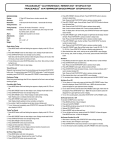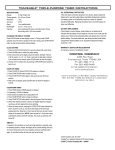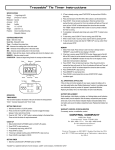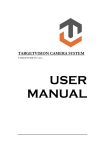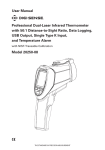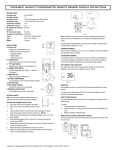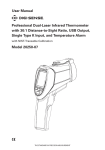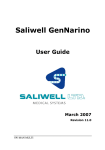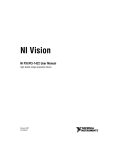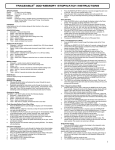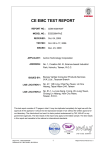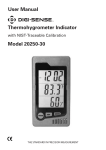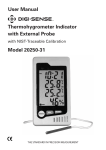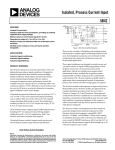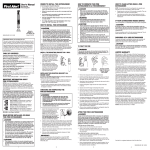Download traceable® jumbo refrigerator/freezer thermometer instructions
Transcript
® TRACEABLE JUMBO REFRIGERATOR/FREEZER THERMOMETER INSTRUCTIONS SPECIFICATIONS Range: -58.0 to 158.0 °F / -50.0 to 70.0 °C Resolution: 0.1° Update Rate: 10 seconds Battery: AAA (1.5V) Probe Supplied: Model 4148-- Supplied with a standard probe sensor with cable. Both sensor and cable may be immersed in liquid. Probe sensor may be mounted using the supplied sensor holder and mounting screw. Model 4548 & 4648-- Supplied with a bottle sensor and cable. Bottle sensor is filled with a patented nontoxic glycol solution that is GRAS (Generally Recognized As Safe) by the FDA (Food and Drug Administration) eliminating concerns about incidental contact with food or drinking water. The solution filled bottle simulates the temperature of other stored liquids. Velcro® and a magnetic strip are provided to mount the bottle to the inside of a refrigerator/freezer and to mount the display on the outside. The micro-thin probe cable permits refrigerator/freezer doors to close on it. TEMPERATURE DISPLAY MODES Ambient Temperature Display Mode (IN): Indicated by “IN” appearing on the display, displays the current ambient temperature and either the ambient temperature memory (MIN/MAX) or the ambient temperature alarm limits (LO/HI). Probe Temperature Display Mode (OUT): Indicated by “OUT” appearing on the display, displays the current probe temperature and either the probe temperature memory (MIN/MAX) or the probe temperature alarm limits (LO/HI). To change between ambient (IN) and probe (OUT) temperature display modes, press the IN/OUT button located on the back of the unit. To change between displaying the memory (MIN/MAX) and the alarm limits (HI/LO), press the MODE button. DISPLAYING °F OR °C To display the temperature readings in Fahrenheit or Celsius, press the °C/°F button located on the back of the unit. MINIMUM AND MAXIMUM MEMORY There are four points that are automatically recorded into memory: Minimum (MIN) Ambient Temperature Achieved Maximum (MAX) Ambient Temperature Achieved Minimum (MIN) Probe Temperature Achieved Maximum (MAX) Probe Temperature Achieved All four memories are independent of each other. Minimum and maximum temperature memories are NOT programmable. The minimum temperature recorded into memory is the minimum temperature achieved since the last time the memory was cleared. The maximum temperature recorded into memory is the maximum temperature achieved since the last time the memory was cleared. The minimum and maximum temperature memories are maintained over the period since the memory was cleared. Minimum and maximum memories are recorded for both ambient and probe temperatures regardless of the display mode. CLEARING THE PROBE (OUT) TEMPERATURE MEMORY 1. Select the Probe Temperature Display Mode by pressing the IN/OUT button located on the back of the unit until “OUT” appears on the display. 2. Press the MODE button until “MIN” and “MAX” appears on the display. 3. Press the MIN-RESET button to clear the minimum temperature memory. The display will show “88.8” under MIN and will then display the new minimum temperature memory. 4. Press the MAX-RESET button to clear the maximum temperature memory. The display will show “88.8” under MAX and will then display the new maximum temperature memory. CLEARING THE AMBIENT (IN) TEMPERATURE MEMORY 1. Select the Ambient Temperature Display Mode by pressing the IN/OUT button located on the back of the unit until “IN” appears on the display. 2. Press the MODE button until “MIN” and “MAX” appears on the display. 3. Press the MIN-RESET button to clear the minimum temperature memory. The display will show “88.8” under MIN and will then display the new minimum temperature memory. 4. Press the MAX-RESET button to clear the maximum temperature memory. The display will show “88.8” under MAX and will then display the new maximum temperature memory. ALARMS Both ambient (IN) and probe (OUT) temperature alarm limits may be set in 1° increments. With the alarm enabled (֠), the unit will sound an alarm when the temperature being displayed is outside the alarm limits that have been set for that display mode (equal to or lower than the low alarm set point, or equal to or greater than the high alarm set point). Example: If the unit is displaying the ambient temperature (IN) and the probe temperature (OUT) is outside the probe temperature alarm limits, no alarm will sound. SETTING PROBE (OUT) TEMPERATURE ALARM LIMITS 1. Select the Probe Temperature Display Mode by pressing the IN/OUT button located on the back of the unit until “OUT” appears on the display. 2. Press MODE button until “LO” and “HI” appears. 3. To set the low temperature alarm limit (LO), press the LO ALM SET button to advance the display until the desired low temperature is displayed. Press and hold the LO ALM SET button to rapidly advance the display. 4. To set the high temperature alarm limit (HI), press the HI ALM SET button to advance the display until the desired high temperature is displayed. Press and hold the HI ALM SET button to rapidly advance the display. SETTING AMBIENT (IN) TEMPERATURE ALARM LIMITS 1. Select the Ambient Temperature Display Mode by pressing the IN/OUT button located on the back of the unit until “IN” appears on the display. 2. Press MODE button until “LO” and “HI” appears. 3. To set the low temperature alarm limit (LO), press the LO ALM SET button to advance the display until the desired low temperature is displayed. Press and hold the LO ALM SET button to rapidly advance the display. 4. To set the high temperature alarm limit (HI), press the HI ALM SET button to advance the display until the desired high temperature is displayed. Press and hold the HI ALM SET button to rapidly advance the display. ENABLE/DISABLE ALARMS To enable the alarm to sound when the temperature being displayed is outside the alarm limits, press the ֠ button located on the back of the unit until “֠” appears on the display. Each successive press of the ֠ button will enable (֠) or disable the alarm. ALARM SOUNDING With the alarm enabled (֠), the unit will sound an alarm when the temperature being displayed is outside the alarm limits that have been set for that display mode (equal to or lower than the low alarm set point, or equal to or greater than the high alarm set point). If the alarm is sounding based on the low alarm limit, “LO” will flash on the display. If the alarm is sounding based on the high alarm limit, “HI” will flash on the display. The unit will continue to alarm and flash the corresponding “LO” or “HI” until the temperature being displayed is within the alarm limits. Once the temperature being displayed is within the alarm limits, the alarm will stop sounding and the corresponding “LO” or “HI” will no longer flash. To silence an alarm manually, press any button. When manually silenced, the corresponding “LO” or “HI” will continue to flash on the display until the temperature is within the alarm limits. When enabled (֠), the alarm will only sound if the temperature being displayed is outside the alarm limits that have been set for that display mode (IN or OUT). Example: If the unit is displaying ambient temperature (IN) and the probe temperature (OUT) is outside the probe temperature alarm limits, no alarm will sound. RESET BUTTON The RESET button located on the back of the unit may be used to simultaneously reset the memory and alarm limits for both the ambient (IN) and probe (OUT) sensor. To reset the unit, press the RESET button. When the reset button in pressed, the following will occur: ● The display will show all segments for approximately 5 seconds. ● The ambient (IN) and probe (OUT) minimum/maximum memory will be cleared. ● The ambient (IN) and probe (OUT) alarm limits will be returned to the factory default value of 10°C (LO) and 30°C (HI). ● The unit will display the ambient (IN) temperature in °C. ON/OFF BUTTON The ON/OFF button located on the back of the unit may be used to turn the unit off when the thermometer is not being used. The minimum/maximum memory and alarm limits are not cleared when the unit is turned off. To turn the unit off, press the ON/OFF button. Each successive press of the ON/OFF button will turn the unit on or off. No alarms will sound and no minimum/maximum memory will be recorded when the unit is off. BENCH STAND The unit is supplied with a bench stand that is a part of the back of the unit. To use the bench stand, locate the small openings on either side of the bottom of the unit. Place your fingernail into one of the openings and flip the stand out. To close the stand, simply snap it shut. WALL MOUNTING THE UNIT Set a screw into the wall at the desired location. Do not set the screw flush to the wall, the head of the screw will need to slip into the receptacle on the back of the unit. Once the screw has been properly set, hang the unit in place by sliding the receptacle on the back of the unit over the head of the screw. USING THE ALARM AND MEMORY TO MONITOR A REFRIGERATOR/FREEZER Following is an example of how to use the alarm and memory to monitor the temperature inside a refrigerator or freezer. This example is provided only as a helpful guide and is not intended to replace existing facility requirements or procedures. In this example, the refrigerator temperature must be monitored and logged for each 24 hour period and certain actions must be taken if temperature falls below 0°C or rises above 5°C at any time during the 24 hour period. 2. Once the above items have been manually recorded, clear both the minimum and maximum temperature memory. (See the “Clearing the Probe (OUT) Temperature Memory” section.) By clearing the memory each day, the minimum and maximum temperature memory will provide a record of the minimum and maximum temperature that has been achieved inside the refrigerator over the past 24 hour monitoring period. The memory will also allow the user to see if the temperature inside the refrigerator went outside of the acceptable range when there was no one available to hear the alarm (overnight). ALL OPERATIONAL DIFFICULTIES If this unit does not function properly for any reason, replace the battery with a new high-quality battery (see the “Battery Replacement” section). Low battery power can occasionally cause any number of “apparent” operational difficulties. Replacing the battery with a new fresh battery will solve most difficulties. BATTERY REPLACEMENT Erratic readings, a faint display, no display, or a battery symbol appearing on the display are all indications that the battery must be replaced. Open the battery compartment by depressing the tab located at the top of the battery cover and lifting it out. The battery cover is hinged at the bottom so that the battery compartment may be opened without completely removing the battery cover. Remove the exhausted battery and replace with a AAA alkaline battery. Make certain to insert the new battery with the proper polarity as indicated in the illustration in the battery compartment. Close the battery cover. Replacing the battery has the same affect as pressing the RESET button. (See the “RESET BUTTON” section.) Unit Setup Example 1. Plug the probe into the unit. 2. Install the battery. 3. Place the probe sensor inside the refrigerator. 4. Place the display outside the refrigerator. 5. Select the Probe Temperature Display mode. (See the “Temperature Display Modes” section.) At this point, if using a bottle probe, allow sufficient time for the bottle probe to reach equilibrium with the true current temperature inside the refrigerator. 6. Set the probe temperature low alarm limit to 0°C. (See the “Setting Probe (OUT) Temperature Alarm Limits” section.) 7. Set the probe temperature high alarm limit to 5°C. (See the “Setting Probe (OUT) Temperature Alarm Limits” section.) 8. Enable the alarms. (See the “Enable/Disable Alarms” section.) 9. Clear the minimum and maximum memory. (See the “Clearing the Probe (OUT) Temperature Memory” section.) 10. Select the probe temperature with Min/Max memory display mode. (See the “Temperature Display Modes” section.) The alarm limits have been set and the alarm has been enabled. The display has been set to show the current temperature inside the refrigerator along with the minimum and maximum temperature that has been achieved inside the refrigerator. If the temperature inside the refrigerator goes outside the alarm limits (equal to or lower than the low alarm set point, or equal to or greater than the high alarm set point), the alarm will sound. If no one is available to hear the alarm sounding (overnight), and the temperature returns to an in-range condition, the memory will provide a record of the single lowest and highest temperature achieved. When the temperatures are recorded into the manual log, the memory will allow the user to see that the temperature inside the refrigerator had gone outside of the acceptable range. Monitoring Procedure Example Keep a notebook or spreadsheet as a manual log. 1. At the same time every day, record the following into the manual log: ● • Current Date and Time ● • Current Temperature Reading ● • Minimum Temperature Reading (MIN) ● • Maximum Temperature Reading (MAX) Warranty, Service, or Recalibration For warranty, service, or recalibration, contact: CONTROL COMPANY 4455 Rex Road Friendswood, Texas 77546 USA Ph. 281-482-1714 Fax 281-482-9448 E-mail [email protected] www.control3.com Control Company is ISO 9001 Quality-Certified by DNV and ISO 17025 accredited as a Calibration Laboratory by A2LA. Control Company Cat. No. 92-4148-00 Traceable® is a registered trademark of Control Company © 2008 Control Company



